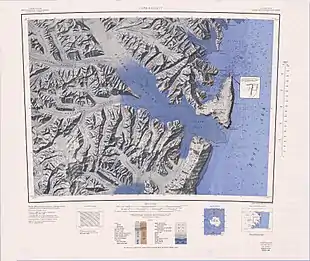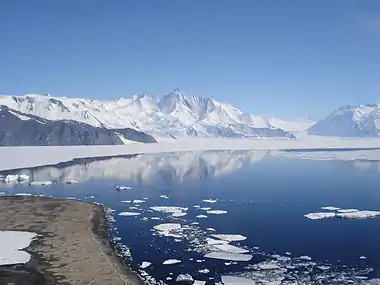Cape Hallett
Cape Hallett is a snow-free area (Antarctic oasis) on the northern tip of the Hallett Peninsula on the Ross Sea coast of Victoria Land, East Antarctica. Cape Adare lies 100 km (62 mi) to the north.

History
In 1956, during Operation Deep Freeze II, USS Arneb was damaged by an ice floe at Cape Hallett.
On 16 October 1958, a Douglas C-124C Globemaster II (52-1017) of the USAF crashed into a 3200-foot mountain near Cape Hallett Bay while maneuvering, killing 7 of the 13 occupants. The Globemaster was on an airdrop flight from Christchurch to McMurdo Station and other navigational errors had occurred prior to the crash.[1]
Hallett Station
Hallett Station | |
|---|---|
 Hallett Station Location of Hallett Station in Antarctica | |
| Coordinates: 72°19′S 170°16′E | |
| Country | |
| Location in Antarctica | Cape Hallett Hallett Peninsula |
| Administered by | International Geophysical Year |
| Established | 1956 |
| Evacuated | 1973 |
| Type | All-year round |
| Period | Annual until 1964 Summer until 1974 |
| Status | Dismantled |

The cape was the location of a joint scientific base, Hallett Station, between the United States and New Zealand during the International Geophysical Year of 1957, and was manned permanently until 1964, when there was a major fire. It was then used as a summer only base until 1973. The site is currently being remediated by removing hazardous materials: fuel, and oil stored in several large tanks. This is an ongoing project which will take several years to complete.
Antarctic Specially Protected Area
An area of 74 ha is protected under the Antarctic Treaty System as Antarctic Specially Protected Area (ASPA) No.106 because it contains habitats with a rich and diverse range of plant communities that are the most extensive and representative examples known at the northern end of the latitudinal gradient of Victoria Land and the Ross Sea. Surveys have recorded 18 species of lichens and five species of mosses, dominated by Bryum subrotundifolium. Animals found at the site include, as well as four species of mites and three of springtails, breeding colonies of south polar skuas and Adélie penguins.[2]
Adélie penguin colony
A large Adélie penguin colony occupies Seabee Hook, on the west side of Hallett Peninsula between Moubray Bay and Edisto Inlet. The history of human impact on the colony through the occupation of Hallett Station, and the subsequent closure of the station, together with the availability of reliable historical data on colony population size, make the site unique and ideal for the study of impacts on, and recovery of, the colony after substantial ecosystem disturbance.[2]
See also
References
- "ASN Aircraft accident Douglas C-124C Globemaster II 52-1017 Cape Hallett Bay". aviation-safety.net. Retrieved 2023-08-09.
- "Cape Hallett, Northern Victoria Land, Ross Sea" (PDF). Management Plan for Antarctic Specially Protected Area No. 106: Measure 1. Antarctic Treaty Secretariat. 2002. Retrieved 2013-03-10.
.svg.png.webp)